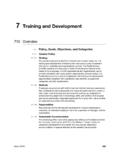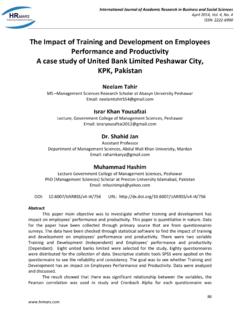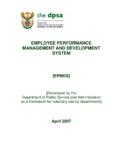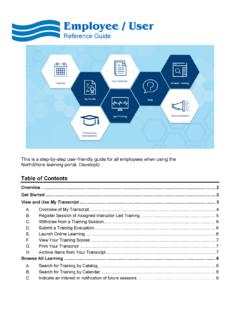Transcription of POLICY AND PROCEDURE FOR DEALING WITH
1 PPOOLLIICCYY AANNDD PPRROOCCEEDDUURREE FFOORR DDEEAALLIINNGG WWIITTHH TTRRAAIINNIINNGG AANNDD DDEEVVEELLOOPPMMEENNTT SAC - Humaann Ressoouurrccess April 2001 1 Table of Contents Page Number 1 Introduction 4 2 training and development POLICY 4 3 training and development Objectives 5 4 training and development Priorities 6 5 training and development Provision 6 6 Job Specific training 7 7 Professional and Vocational training 7 8 Career development 9 9 Identifying training and development Needs 9 10 Nomination PROCEDURE and training Records 11 11 Day Release and Distance Learning Facilities 12 12 Reimbursement of training Expenses 14 13 Repayment of training Expenses 16 14 Evaluation of training and development Activities 18 Appendix 1 Learning Agreement 20 Appendix 2 - Commitment to training - 23 Appendix 3 - training Course Evaluation 24 Appendix 4 (a) Request for Cash Advance 25 Appendix 4 (b) Settlement of Cash Advance 26 Appendix 5 Human Resources Contact Points 27 Appendix 6 The training Link 29 3 AYRSHIRE VALUATION JOINT BOARD training AND development POLICY AND PROCEDURE 1 Introduction References to internal training in this POLICY include training courses provided by the Board s Lead Authority (South Ayrshire Council).
2 Ayrshire Valuation Joint Board recognises that the training and development of its employees has an important contribution to make in the achievement of its corporate objectives, the provision of quality services and in the maintenance of an effective, well-motivated, work force. The Board will provide appropriate training and development to enable employees to acquire the qualifications, skills, and knowledge necessary to perform effectively the duties and responsibilities of their posts. Such provision will also take into account career development and progression opportunities with respect to the Board's future work force requirements. The Scheme applies to all employees and the Assessor will take account of the training and development needs of all when considering training plans and budgetary provision for training and development .
3 All employees are encouraged to take responsibility for their own personal development and together with managers are welcome to contact the appropriate Human Resources staff at any time to discuss any training related issue. 2 training and development POLICY Ayrshire Valuation Joint Board acknowledge the important contribution all employees make towards achieving the corporate aims and objectives of the Board and are committed to promote and protect the interest of all employees by helping them reach their full potential through appropriate training and development . This POLICY extends to all employees including those engaged on a part-time basis and aims to provide a planned and systematic approach to training and development at all levels throughout the organisation.
4 4 3 training and development Objectives The overall objectives of the Board's training and development Scheme are: To ensure that the Board has sufficient trained, qualified and experienced employees to meet its current and anticipated service needs; To provide the training needed to enable employees to perform their present jobs effectively and to acquire new skills relevant to the duties they will require to undertake; To provide the training needed to ensure that employees are able to discharge their statutory duties in terms of health and safety legislation and to assist the Board in discharging its responsibilities as an employer; To assist employees to develop their potential for career progression consistent with the needs of both the Board and the individual employee; To meet effectively the training and development needs both of the Board and its employees in terms of quality and cost, by using both the Board's own resources and, where appropriate, external facilities and/or training providers; To assist the Board in developing and providing the best possible service to the community by encouraging all employees to maximise their potential; To provide equal access to appropriate learning opportunities for all employees.
5 To provide all training and development opportunities at appropriate levels of quality and value for money. These objectives will be achieved by: Ensuring that assessment of training and development needs is carried out on a regular basis. Ensuring that appropriate training is made available to enable employees to reach and maintain satisfactory performance in their jobs. Provide training to those employees identified for new or different roles within the organisation in the future. Providing appropriate support and advice to employees wishing to embark on relevant professional studies. Encouraging all employees to accept responsibility for and to contribute towards their own self- development .
6 Evaluating all training and development activities (internal and external) on a regular basis to ensure satisfactory provision. 5 4 training and development Priorities The Board recognises that in order to deploy its available resources to the best advantage, certain priorities need to be established. The Assessor will decide their own priority needs in the light of available resources and operational commitments. It will be the responsibility of the Assessor to include in his prioritisation considerations, training and development required: To induct new employees; To equip appropriate employees with the skills, knowledge and attitudes needed to effectively participate in promoting and delivering quality services; To assist the introduction of new technology, new equipment and/or new organisational procedures; To promote good employment practices and industrial relations and job satisfaction for employees; To promote the effective implementation of the Board's Equal Opportunities POLICY and its obligations under various employment related Acts.
7 5 training and development Provision The Board will provide training and development opportunities which will include the delivery of an internal training programme and access to Open Learning facilities. Employees will be expected to take advantage of internal provision in the first instance and attendance at external events will only be approved where no suitable internal provision exists. training and development opportunities may include: i) Job Specific training which will focus and target training , usually of a short duration, to increase competency in one or more selected areas of an employee's current job; ii) Professional and Vocational training which leads to a qualification awarded by a relevant professional or vocational body; iii) Career development aimed at enhancing employees' future employability or promotion prospects and either deepen or widen knowledge in areas of current job responsibility or provide the individual with new areas of competence, knowledge and understanding.
8 6 6 Job Specific training Employees should be encouraged to increase competency, efficiency, work rate or performance and to adapt to innovation whether POLICY driven or related to new processes or technology. training options may include; i) Internal Courses. ii) External training and development Events. 7 Professional and Vocational training Facilities and financial assistance may be granted to prepare employees for undergraduate and post graduate level qualifications. Further Education Provision may include courses of study leading to Modules, Certificates, MBA, MSc and Diplomas. Courses of this nature will generally involve attendance by day or block release or evening classes.
9 Day or Block Release Day or block release facilities will be provided, where available, for employees at the commencement of the further education session. Where an employee, at the commencement of the further education session, already has the appropriate entrance qualifications and is given day or block release facilities to undertake an authorised course of studies towards gaining an approved basic qualification, the Assessor will normally undertake to continue such facilities until the employee has successfully completed the course subject to satisfactory progress being made throughout the course. Facilities to continue further study on a day or block release basis for a higher qualification may be granted at the discretion of the Assessor.
10 Subject to the exigencies of the service, day or block release facilities may be granted to employees to undertake an authorised course of studies leading to an approved professional or vocational qualification. The continuance of day and block release facilities will be subject to satisfactory progress being made throughout the course of studies. When an employee is given day/block release facilities to pursue a course of studies leading to a professional qualification essential to the practice of the profession to which the employee has been recruited, such facilities will be guaranteed to the employee until the completion of that course of studies, subject to satisfactory progress being made throughout the course.







